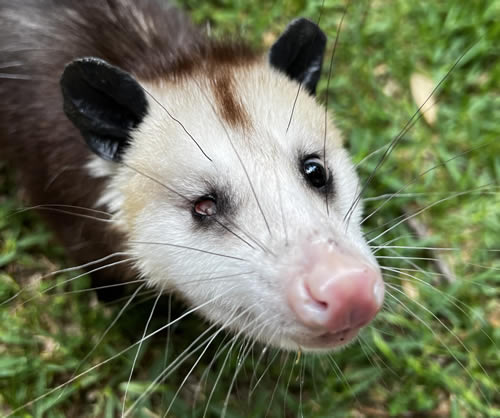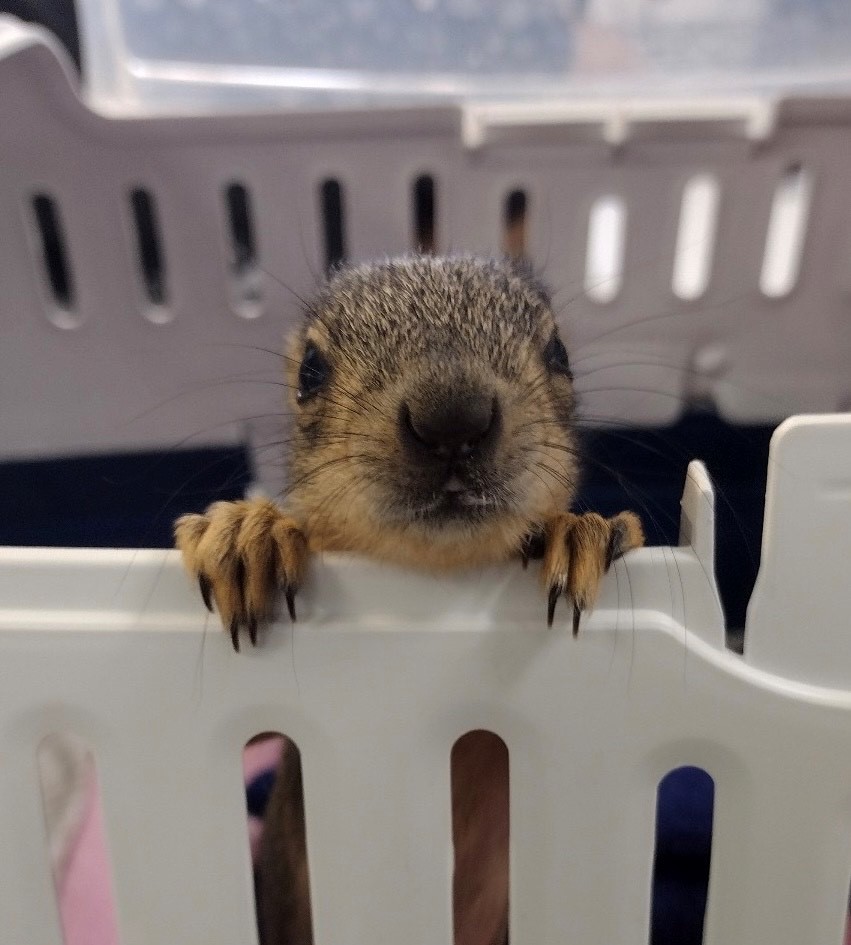Methods for Attracting Wildlife
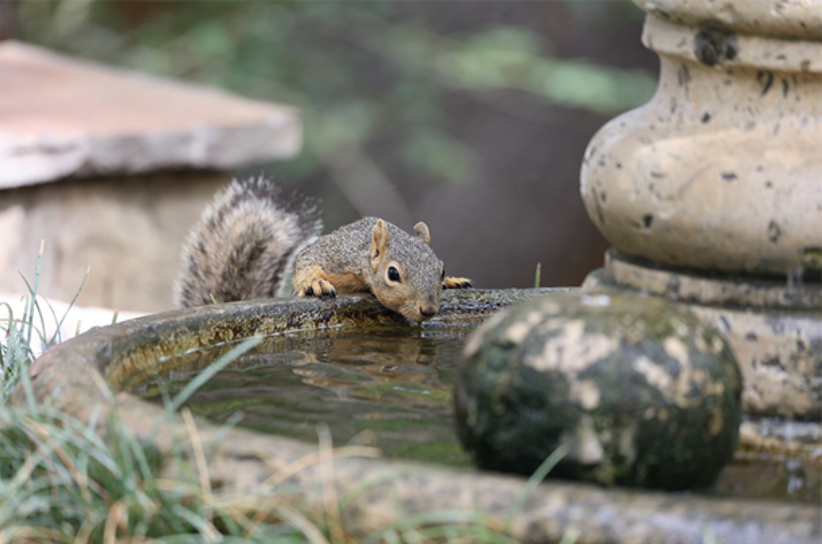
Introduction
Attracting wildlife to your yard can be very fun, rewarding, and entertaining! If you love animals, insects, and all things nature, there are so many ways to promote a healthy environment in your yard for these creatures. There are many ways to attract wildlife to your yard and at the same time promote biodiversity to protect our natural ecosystems. Attracting wildlife can also help control pests in your yard, can provide educational opportunities, help with conservation efforts, and of course enhance the natural beauty of your yard!
Attracting wildlife can be a team effort, so it may be a good idea to have a friendly conversation with your neighbors regarding attracting wildlife and helping educate them if they are unsure about it. If they seem interested or unsure, sharing this webpage with them may be helpful! If wildlife visits your neighbor's yard, they may be more inclined to check out your yard as well!
Important note to add: Wildlife must remain afraid of you. Please do not encourage them to approach you or to take food from your hands. If an animal sees you as a friend and becomes comfortable around you, it will likely approach other humans, which may not be wildlife friendly like you are and may cause them harm or death. Please do not attempt to train wildlife to approach you. We want wildlife to keep a healthy distance and a healthy fear of humans, because we are not all their friends. If a wild animal is approaching you, there is likely something wrong with it. Please observe wildlife from a safe and respectful distance.
HELP US KEEP WILDLIFE WILD!
Attracting All Wildlife
There are some attractants that you should consider adding to your yard to bring all types of wildlife around.
First, water sources. You can place different types of water sources around the yard to promote a variety of wildlife visiting your yard. Keep the water source clean and sanitary to avoid spreading diseases and parasites between wildlife. There are a few acceptable ways to clean water sources, including scrubbing with hot water and dawn dish soap, scrubbing with 1 part vinegar and 9 parts water, or for filthier water sources with algae growing a bleach solution made with 1 part bleach and 10 parts water could be used to scrub thoroughly. After scrubbing, please ensure that you rinse well to make sure you remove any bleach or dawn residue. They should be cleaned 2 to 3 times a week for best results. Some wonderful water sources to add to your yard can include:
- Birdbaths
- Ponds
- Water drippers
- Bowls
- Streams
- Waterfalls
Creating a healthy ecosystem will increase your chances of wildlife calling your yard home. You should plant a variety of plant species in your yard, including some of these:
- Conifers
- Evergreens
- Herbs
- Native trees
- Shrubs
- Flowers
With this, you’ll need to promote healthy soil for your year-round wildlife garden, which you can do by using compost, mulch, and well-rotted manure. Organic matter will add nutrients to promote future crops growth. You can also mix in leaves and grass clippings with the organic matter in the soil. It’s also a good idea to not clean up your flower beds in Autumn. The seeds provide welcome sustenance for birds and the plant skeletons offer shelter for a variety of wildlife as well. A friendly four-season wildlife habitat may have brushy or grassy areas, fallen trees, trailing groundcovers, or rock piles. Try to make your year-round wildlife garden similar to what you typically observe in nature.
Eliminating pesticides (including rodenticides), herbicides, and insecticides can ensure you are not killing any of the wildlife that may come around. It is very easy to kill many types of animals if you are using these, not just what you are targeting. Insecticides on insects can kill the animal that is consuming it. For example, if a fly has an insecticide on it and a praying mantis or bird consumes it, they may die from consuming it as well (biomagnification). Please consider finding alternative options. Glue traps are also very important to avoid. You may be trying to catch a mouse, but you will likely catch and kill something else. Please look into humane traps or deterrents for things like mice and rats. There are great alternatives out there, such as a live mouse trap from Amazon (then relocation of the mice). Creating a healthy ecosystem in your backyard is actually a great form of natural pest control.
Less human and pet movement in the yard will be more intriguing for wildlife to come around. We are predators to them, so they will try to avoid us as much as possible. The best thing to do is watch wildlife from a distance or inside the house from a window. If you have pets, consider going in the yard before them to make noise such as clapping before they come out so there is no chance of the wildlife being caught, injured, or killed. Be sure to check for baby animals or injured animals around the yard before letting them out as well.
Bring on the wildlife!
Attracting Mammals
Squirrels, opossums, skunks, rabbits, deer, and raccoons are some of the interesting mammals you could find in your yard throughout the year.
Brush shelters, dead trees, and hollow logs can provide great shelter for wildlife in your yard. Wildlife will find refuge in these areas in the environment. These areas give wildlife hiding spots to avoid predators. Insects, which are a food source for many animals, will also be attracted to these areas and make it their home. These insects become a protein-rich food source for their predators.
Brush piles are often made up of a pile of sticks, leaves, logs, stones, pine needles, and more. They should be placed somewhere that is a good distance from the house, like by the corner of a fence or behind a shed. It’s best to make many small entrances for wildlife to use, about 6 to 12 inches wide each. The brush pile itself can be as large as you’d like for it to be. A good range would be from 3 to 8 feet tall and from 6 to 20 feet wide. This will give ample space for a variety of wildlife to make use of.
Dead trees and hollow tree logs can also provide great shelter for many animals. Many animals, such as squirrels, raccoons, skunks, bats, and birds, will find a home, nesting sites, and food sources within these trees and hollow logs. They will also provide great food sources for wildlife to take advantage of, such as insects, mosses, lichens, and fungi. These hollow logs will create great hiding spaces for animals to use. Finally, dead trees can provide high branches for predators like raptors to look out from to spot potential prey with no leaves to block their view.
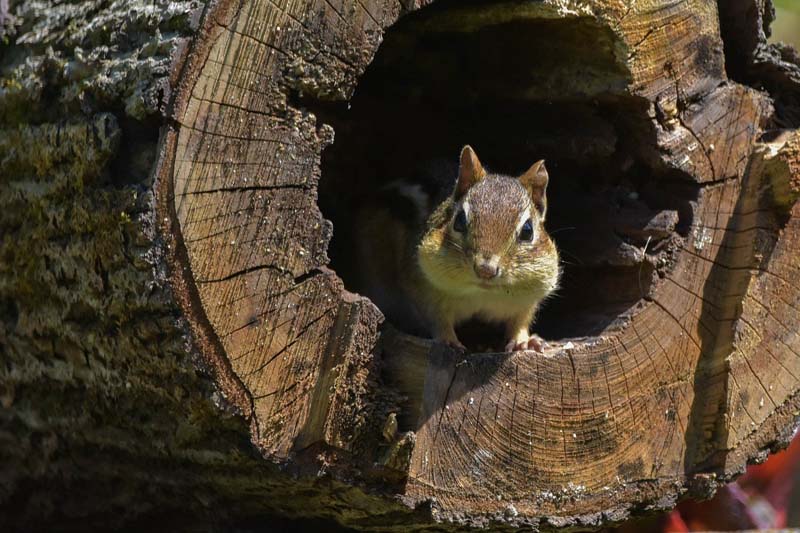
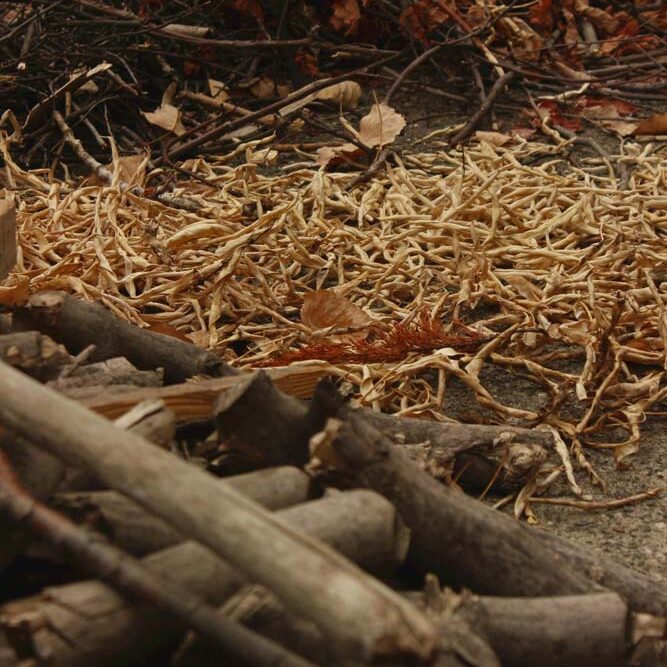
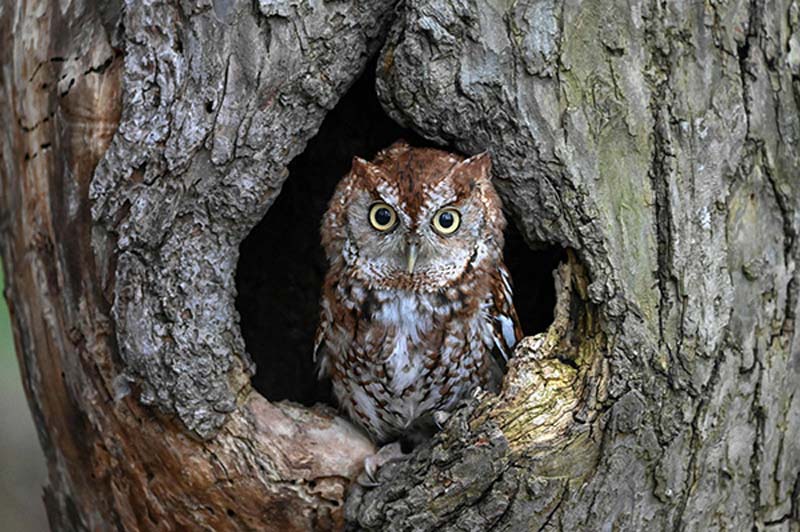
If you’re looking to attract more squirrels to your yard, you should think about purchasing or building a squirrel house or nesting box. They can provide a place for squirrels to call home and somewhere to keep warm. They can also provide shelter away from predators in the area. Another fun way to attract squirrels to your yard (and also to entertain yourself at the same time) is to purchase or build a picnic table corn-on-the-cob holder for squirrels to munch on. They love it, and it’s such an adorable thing to observe! Some other foods squirrels enjoy eating are fruits, vegetables, nuts, seeds, and birdseed. Squirrels should be given their own seed and nut bowl or have some spread out over the yard if you want them around so that they have their own place to eat instead of scaring off the birds from bird feeders. Keeping the birds and the squirrels separated will help to keep harmony in your yard and continue attracting the birds instead of scaring them off.
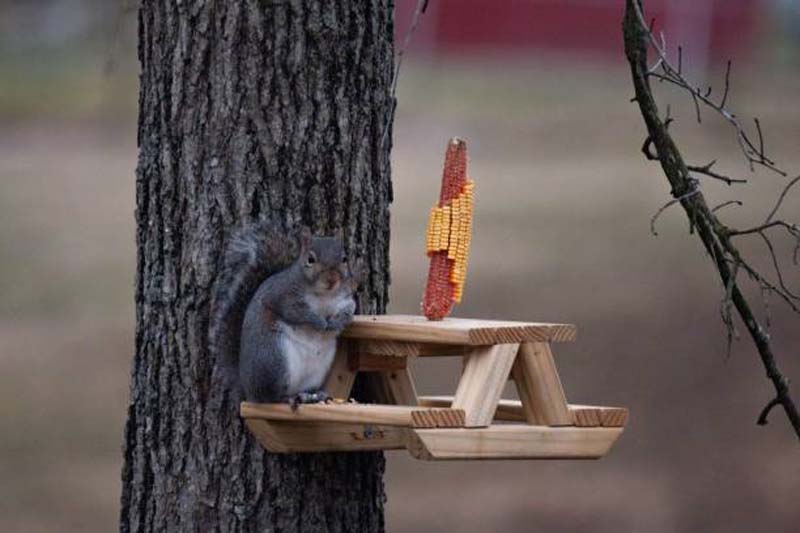
Another mammal you may catch enjoying vegetables, native plants, and grasses in your yard, is rabbits. On occasion, it is ok to spread rabbit pellet food out throughout your yard. They will need to be fresh pellets, because rabbits do prefer fresh foods. Spreading them out across the yard will encourage them to forage like they should be doing naturally in the wild, rather than training the rabbits to come to a bowl and causing them to depend on you. Rabbits also enjoy bushes or trees, and typically build their nests (shallow, in the ground nests, covered in a mixture of dried grass and fur) in those areas. The babies will stay in the nest for the first three weeks of their life, so if you want them to survive and possibly stick around, you should keep your pets away from the area until the babies have left the nest.
Another tactic to try and attract skunks to your yard is to leave spaces open under decks, sheds, wooden porches, or concrete steps for them to create a den in the wintertime. Freshly laid sod is an attractant for them as well due to the earthworms, grubs, and insect larvae that may be living in it. Skunks eat both plant and animal matter, so both kinds of food sources would be good to have in your yard. They typically eat small rodents, birds and their eggs, insects, fruits, nuts, and plants, and will also scavenge on garbage, birdseed, and pet food. Like with other mammals, if you are planning on putting food out for them, you should spread it out over the yard, so they need to forage for it like they typically do for food in the wild and don’t become dependent on a bowl of food you put out for them.
Racoons are also opportunistic eaters, and will eat just about anything they find. From fruits, nuts, dog food, insects, to garbage, they will enjoy all of it. They also enjoy dark spaces and prefer to be out when it isn’t bright out. With lights outside turned off at night, you may have a better opportunity to see them roaming your yard. They will also be looking for a den to raise their young at times, so the brush piles and open spaces under things like decks and wooden porches will come in handy for these visitors as well.
If you’d like to see deer visit your yard, there are a few things you can try. First, plant some forage plant species that deer usually enjoy feeding on. Some of those include Alabama Supplejack, American Beautyberry, Cedar Elm, Deciduous Holly, Roughleaf Dogwood, and Virginia Creeper. Here is a document listed on Texas Parks and Wildlife Department’s website as well that lists their favorite browse plants they enjoy:
https://tpwd.texas.gov/publications/pwdpubs/media/pwd_br_w7000_1222.pdf
Deer also enjoy high protein crops and nuts. If you live nearby a large field of crops that they will eat, consider planting different crops or browse plants (small flowering plants that grow in groups called “browses”) so that you will still attract them away from the abundance nearby. Deer will feed on the leaves, twigs, buds, and tender branches of the shrubs of browse plants. You should also make sure the food has some distance from the road, because the cars may scare them away from your yard, and they may even get hurt. Next, deer lures can peak a deer's interest as well. Some of the lures and scents that may work to attract deer include:
- Lures that consist of a variety of scents, including pheromones, urine, and foods. These can be spread across your yard where you’d like to attract deer to. Deer will often come visit these smells to check out the new strange smelling deer in the area.
- Lures that smell like a doe can be spread out on the grass as well to attract bucks. It will typically attract them for a few months before the breeding season begins in November.
- Human scent will deter the deer, so try avoiding getting the deer lure on yourself.
- Apples are a scent deer may come to check out as well. Apple trees can be planted in your yard, or you can mix some cut up apples with deer feed or grain in a bucket in your yard or spread out across the yard.
- Salt and mineral blocks can be added to your yard for them to enjoy near another food source for them to find if they are in the yard as well.
Another thing to keep in mind about deer is they like to be in areas that provide cover to them and their food source, so you may want to consider letting the grass on the perimeter of your yard grow much higher to provide that necessary comfort for them. Fences can also deter them if there isn’t an easy way in and out, so consider leaving your yard fence-free or have some openings in the fence for the deer to easily get through. Lastly, deer may be frightened and avoid areas with lots of sound and light, so try and keep your yard area quiet and dim later in the day.
With food, cover, and a water source in your yard, you may also attract rodents. Please be aware that attracting rodents to your yard may also attract raptor bird species and snakes to your yard due to their attraction to prey, and they will feed on most wildlife that may come to visit your yard. These predators are a natural part of the ecosystem and should be respected, not feared.
Opossums, squirrels, rabbits, oh my!
Attracting Birds
Songbirds, doves, raptors, and different species of waterbirds are some of the incredible birds you can try attracting to your yard. If you’re a bird lover, you know how fun it is to get to bird watch from inside or outside your home. Some great additions are different types of water sources, different types of bird houses, and different types of bird feeders.
There are a few things you can enhance your yard with to attract many species of birds. Birdbaths, bird feeders, high places to perch, and planting native species will all help welcome birds to your yard. You should always keep birdbaths and bird feeders as clean and sanitary as possible by cleaning them often. If they aren’t regularly cleaned and sanitized, they can make the birds sick and even spread infectious diseases. You can use either dish soap and boiling hot water or a dilute bleach or vinegar solution to clean and sanitize. There are standup birdbaths, dripper birdbaths, and fountains, so you can explore which option you’d like in your yard the most, or have a combination of them.
There are many types of bird feeders and feed that you can put out. You can also place bird feeders in trees or use a bird feeder pole system to hang your feeders from. Birds enjoy a variety of seed and nut mixtures, and also enjoy insects such as mealworms added in. If the seed you use doesn’t contain any grit, which birds need to properly digest their food, you can add something to replace the grittiness, such as crushed up eggshells, fine sand, or crushed charcoal. About a teaspoon of the gritty substance should be added to each quart of birdseed used. Plant species can attract birds with fruit that they can feast on, and they will also spread the plant's seeds and promote a healthy ecosystem. You can also place ripe fruit or berries on a stand near feeders for birds to feast on if they are hungry.
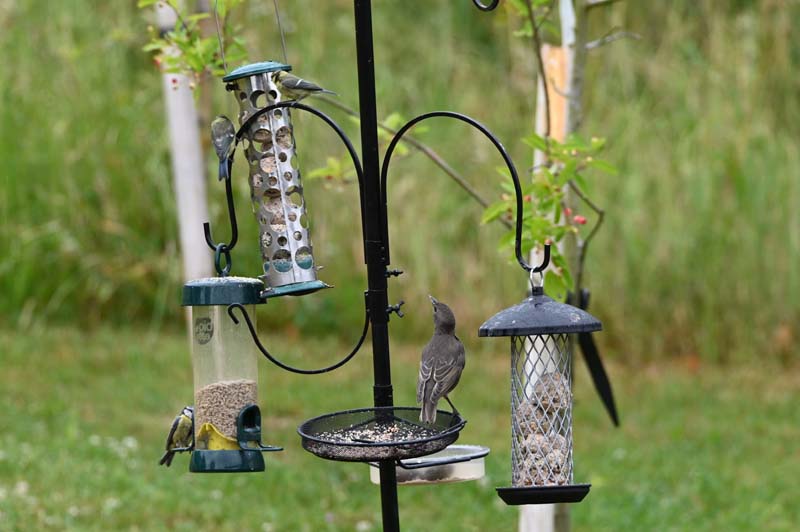
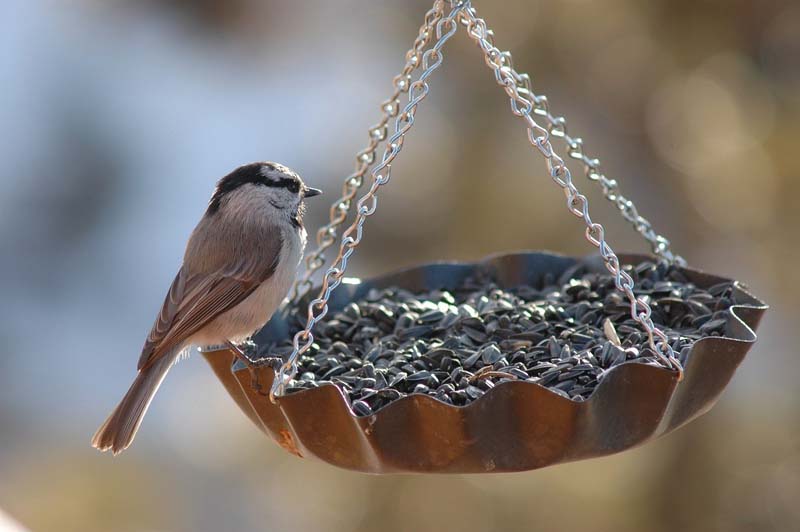
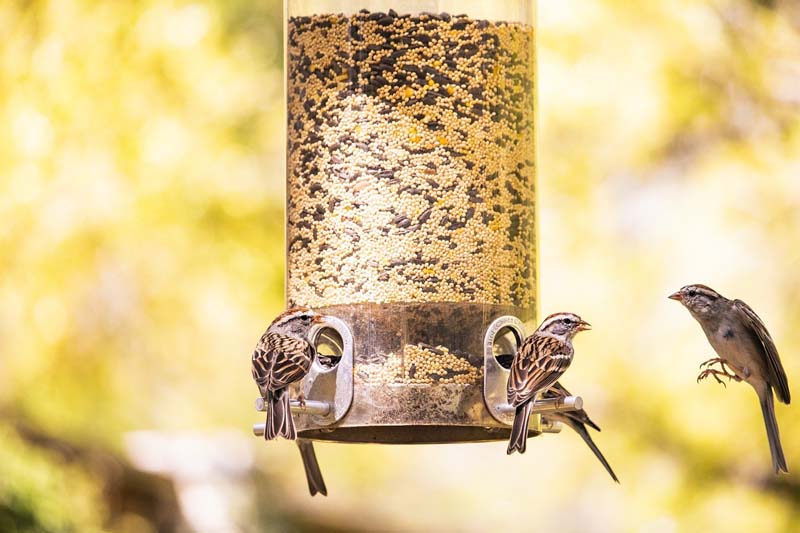
Hummingbird feeders are specifically for hummingbirds. The flying saucer shaped hummingbird feeders that are bee resistant are some of the best for them, but there are different types. Ant moats can be added to the feeders to avoid ants getting inside. They will hang above the feeder, with the feeder attached to the bottom of it, and be filled with water so that the ants will be stuck in the water and unable to get down to the feeder. Nectar is better off made at home than store bought, as sometimes those have ingredients that make it less safe for a hummingbird to consume. Red dye should not be added, nectar should only include sugar and water.
Nectar Recipe:
- Boil 1 cup water (4 parts)
- Mix in ¼ cup refined white sugar (1 part) until completely dissolved
- Let cool
- Fill feeder
Nectar should be changed frequently and the feeder should be cleaned regularly. To attract more hummingbirds, display other red objects in the yard such as red flowers, red ribbons, and red feeders. High perches, such as tall shrubs and branches, are great spots for the hummingbird to perch and rest. They will also benefit and be attracted to an insect feeder for a source of protein.
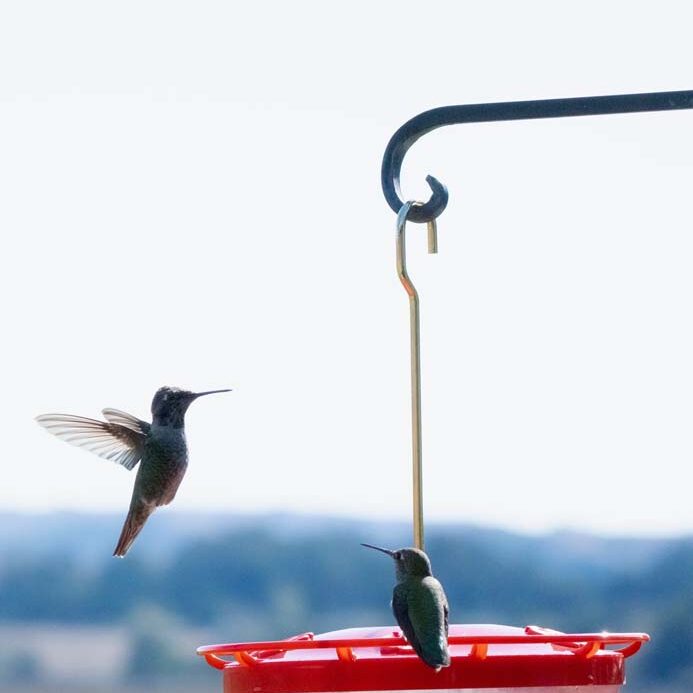
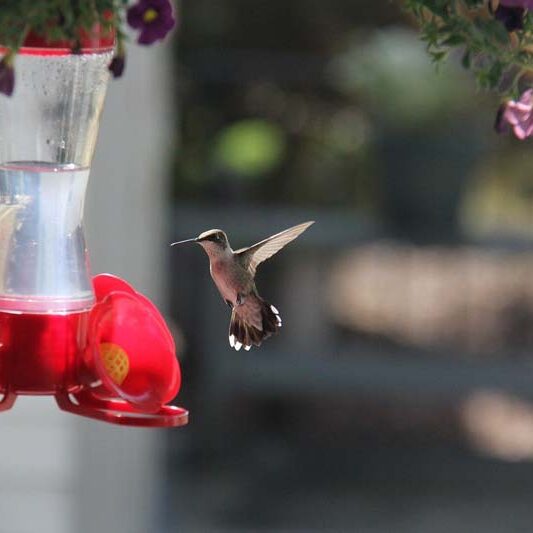
Bird houses and nesting boxes can attract a variety of birds as well, and the many types of bird houses may each attract different bird species. Song bird houses will help to attract many different species, such as house finches, sparrows, and bluebirds. With bird houses, or nesting boxes, you may get to observe baby birds when they’ve fledged from the nest. Fledglings will usually be seen hopping around on the ground for up to a couple of weeks while they are still learning to fly. Their mother still cares for them during this time, so unless you notice an injury or that they’ve been caught by something, it’s best to leave them alone and observe from a distance for an hour straight to make sure they are still being cared for. With that being said, keep this in mind when you have pets in the yard. Check for baby birds in the yard before letting the pets out if you are able to to make sure they remain safe. Some birds will also make nests in strange places, so if you see a bird flying in and out somewhere, chances are there may be a nest and babies inside that they are caring for. House sparrows, european starlings, barn swallows, and chimney swifts are some of the most common birds to see nesting on homes, in gutters, or on other man-made structures. Birds will also divebomb at you if you’re near their nest or their young, so keep a distance if you can. Bird houses should be kept clean, as unclean bird houses can spread diseases and parasites. Bird houses are best cleaned after the baby bird season is over, such as in September or October.
Purple martin houses are specifically made for purple martin needs, including living in large colonies. Those should be at least 10 to 14 feet off the ground on a pole system, or even higher. They should also be at least 40 feet from other tall objects such as trees or buildings. For more information on them, check out the Purple Martin Conservation Association’s website: https://www.purplemartin.org/
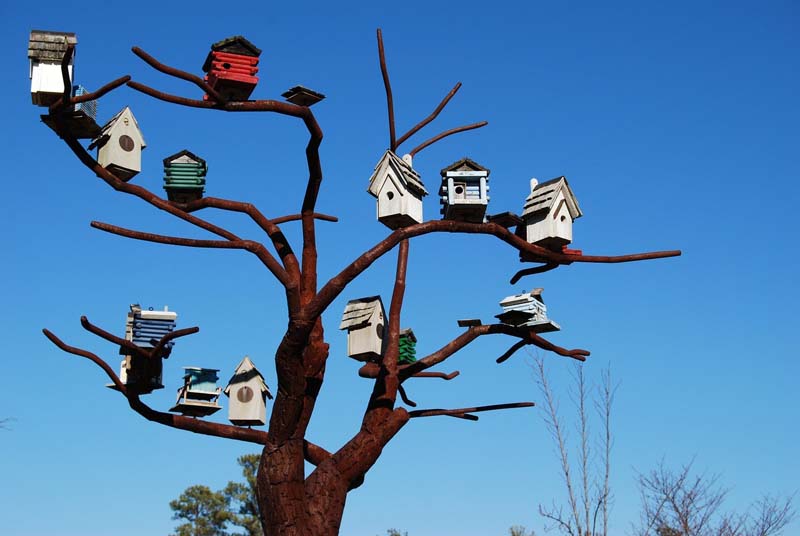
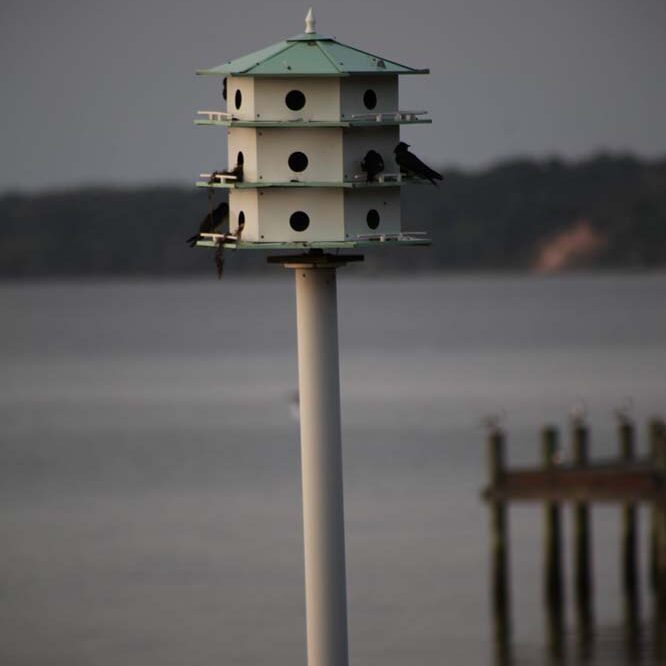
Brush piles can also provide shelter and cover from extreme temperatures and weather year-round. They will also give food opportunities for the birds with insects living around and within the brush piles. These are best placed in corners of the yard away from high traffic areas. Dead trees should also be left in place for many bird species to use for resting, food storage, nesting, hunting, and roosting.
Some foods that woodpeckers enjoy are peanuts, mealworms, suet, berries, sap, and sunflower seeds. Suet in a wire cage feeder is perfect for woodpeckers to hang on and eat. Woodpecker specific feeders are the best, as they typically provide much needed support for their feet and their tail to press up against. They need something that they can securely press their tail against when they start pecking at the food in the feeder. Woodpeckers are shy birds, so they prefer an isolated bird bath to drink and bathe in. A ground bird bath with a dripper is a good idea to attract their attention. Dead trees are very important to woodpeckers because they provide food, nest sites, and homes for them. Insects and grubs are often in dead trees and tree stumps. Woodpecker birdhouses are great because they remind them of the excavated cavities in trees that they typically nest in. The birdhouse should have at least a 1.5 inch opening and a 9” to 15” depth inside. They should be nailed to a tree at least 10 to 20 feet off the ground. Below is a woodpecker house vs. a regular bird house.
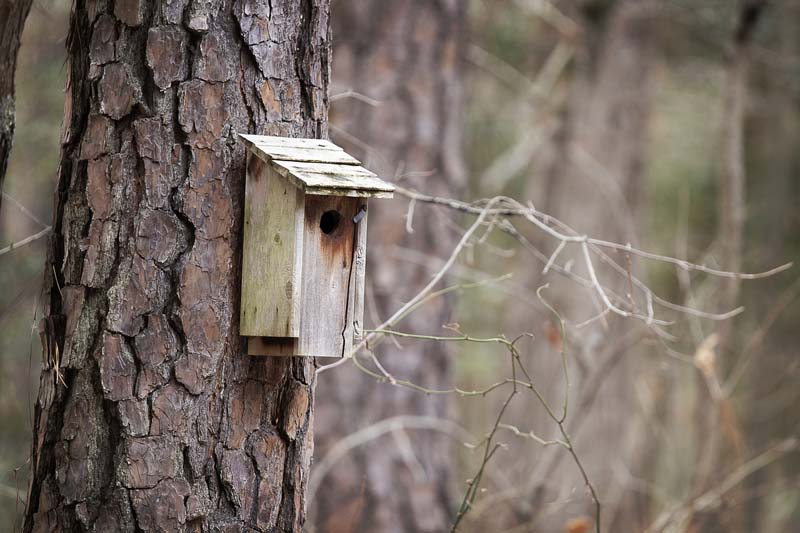
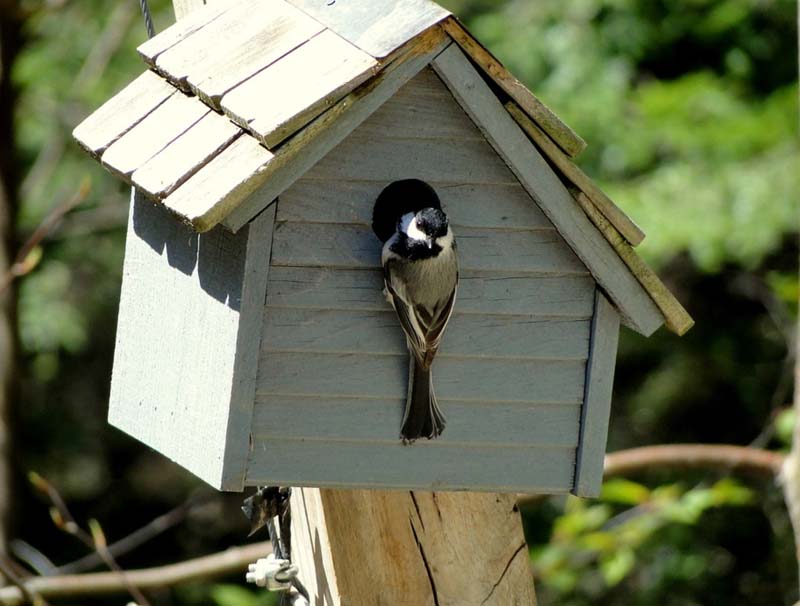
If you have a good water source, such as a freshwater pond, attracting waterfowl such as ducks to your yard can be such a fun and rewarding experience. Some foods you can feed to ducks as treats in small quantities include grapes (cut in half), cracked corn, barley, oats, birdseed, grains, peas, and duck feed pellets. Leafy greens such as weeds, grass, romaine lettuce, chard, etc. can be fed in unlimited amounts. Bread should never be fed to ducks because it’s essentially junk food with very little nutritional value and will cause things like obesity and malnutrition. Ducks also enjoy rest time, so having logs and rocks can give them a good spot to relax.
Screech owls are super fun to witness and great pest control for your yard as well. By attracting other animals to your yard, you are more likely to see owls and other raptors come around. They will eat small mammals, flying insects, and birds. Screech owls typically begin nesting season in February in the southern states. Screech owl nesting boxes can be bought or built to encourage nesting in your yard. You should nail them to a tree, post, or building about 10 feet high that are at least the width of the box. Place wood chips or dry leaves in the bottom of the nesting box. You can install a predator guard to avoid squirrels making it their home. Once females lay their eggs, try to avoid disturbing them, because they will sometimes abandon the nest and not come back.
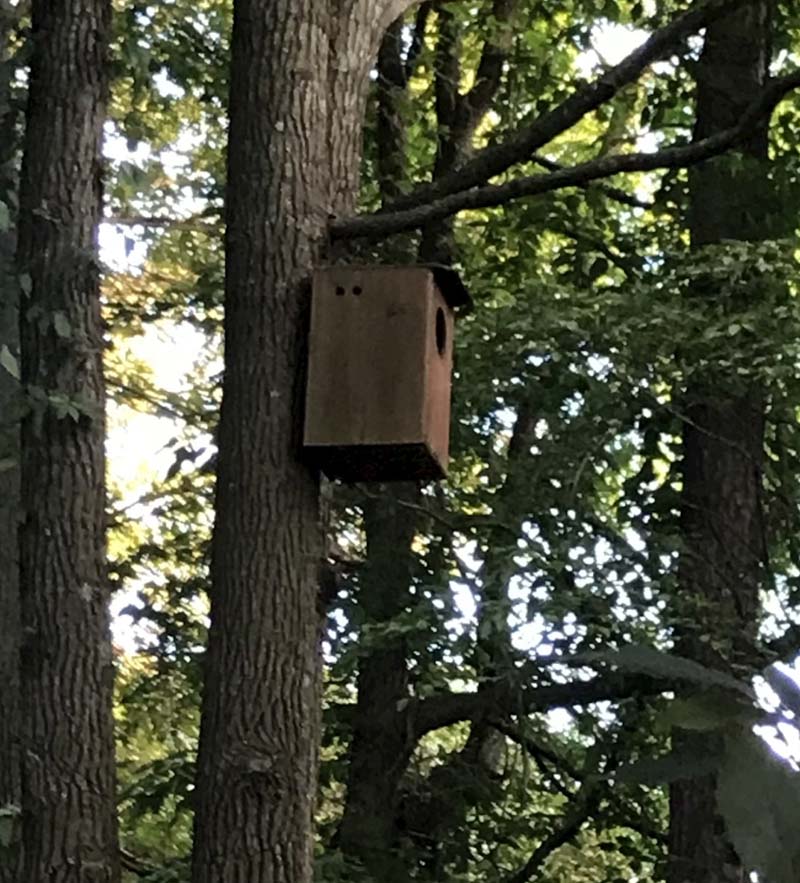
Be aware that attracting birds to your yard may also attract other raptor bird species to your yard due to their attraction to prey. These predators are a natural part of the ecosystem and should be respected, not feared.
Bird visitors are welcome!
Attracting Reptiles and Amphibians
One of the most important additives to invite reptiles to your yard besides a water source is brush piles or rock piles. They will create great hiding spaces, especially for animals like snakes. Other ideas for hiding spaces include bushy perennials or man-made items like stacks of bricks or pipe with crevices in between them. Lush vegetation will give reptiles and amphibians great hiding spaces as well. For lizards you should also include areas for them to bask in the sun. Large rocks, concrete blocks, or a stone wall will absorb and retain daytime heat for cool nights. Snakes and turtles will enjoy these basking spots as well. In their water source you may need some type of ramp for animals like lizards, snakes, and frogs to have better access to it. You may use rocks, logs, a towel draped over the edge, a FrogLog, or many other things to create a ramp. If you have a pool, a FrogLog is great to keep on the edge for wildlife to use if they fall into the water and get trapped. You should avoid mowing at night and keep pets in at night as well so that they will come out without being scared off. If you hope to see box turtles in your yard, which isn’t as common, keep leaf litter in the yard and make sure there are moist areas or a small bog.
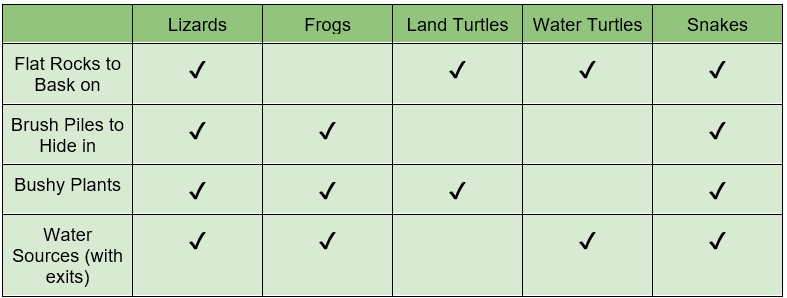
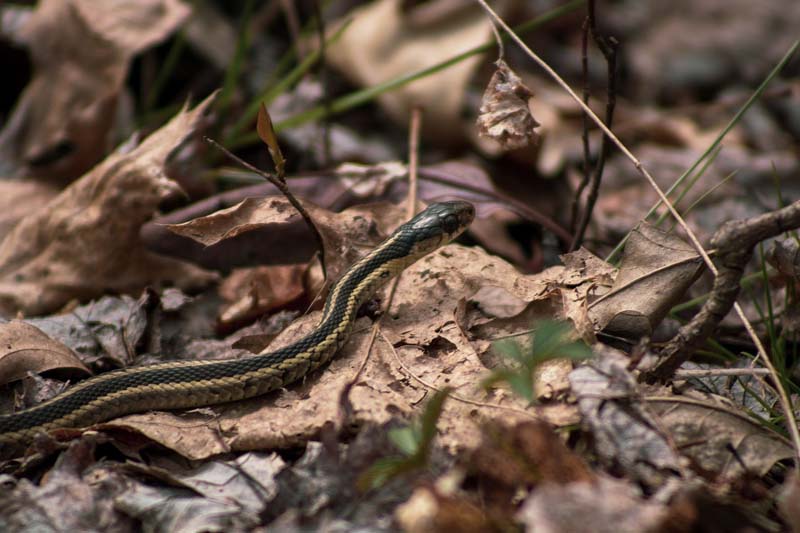
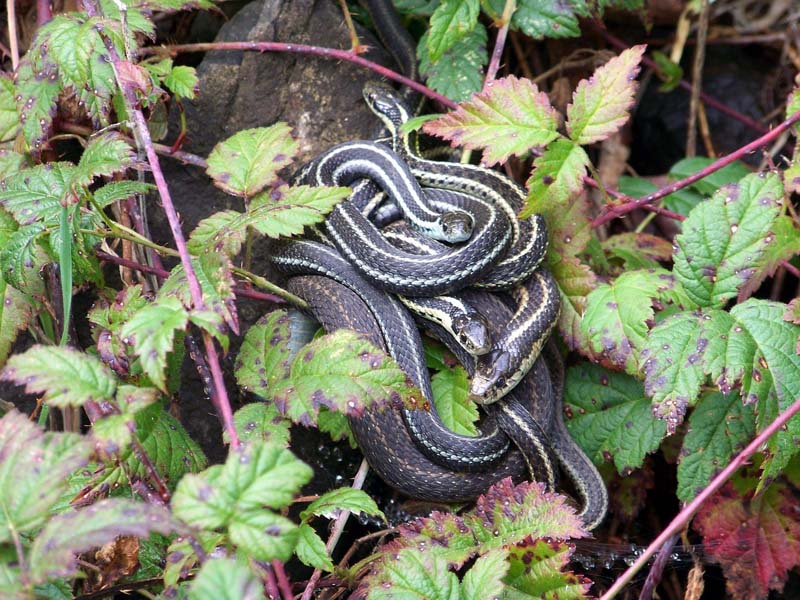
For amphibians, you should keep wetlands and ponds natural, or create an area for them that appears natural. Ponds are great areas for amphibians, so creating a pond can encourage them to come to hang out. Ponds should be filled with native water plants to help create a natural habitat for the creatures and lush vegetation should surround the pond. FrogLogs can be great to keep on the edges of pools or ponds if there aren’t any other natural ramps present.
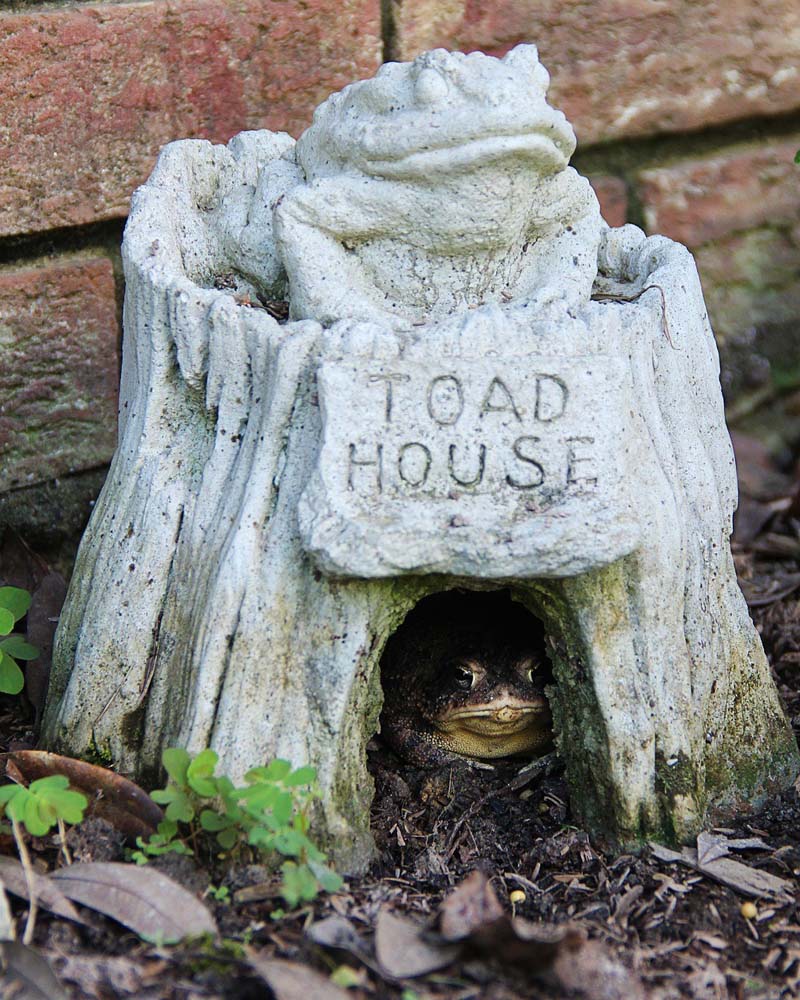
For toads, toad houses can be purchased or built to give them a home. Something as simple as a ceramic pot broken in half and buried a bit into the soil on its side will work. The bottom should always be exposed to the soil, because toads like to burrow themselves into the soil a bit. Toad houses can be as simple or elaborate as you’d like.
Hiding spaces are key!
Attracting Bats
Bats are the only winged mammals that are capable of incredible flight. They can be so fascinating to watch in your yard as they swarm at night looking for insects to munch on.
Bats are great pest control. A single bat can catch and eat 1,000 mosquito sized insects in one hour! Planting native plants in your yard rich in pollen and nectar is a great attractant for bats because of the insects that will be present and create a food source for the bats. It’s best to plant flowers that stay open or bloom in the evening because that’s when bats will be out and feeding on flying insects. This website can help you find native plants for your area: https://www.nwf.org/nativePlantFinder/plants
For a bat water source, they need to be able to swoop down onto the water surface to take a drink and fly back off from the water. Therefore, you should make sure the area isn’t obstructed by branches or other things.
Hanging a bat house is a great way to invite bats to make a home in your yard and raise their young. There are many different types and sizes of houses. Bat houses should receive at least 6 hours of sunlight a day in warmer climates and even more in cooler climates. The best place to hang them is on a building hopefully at least 15-20 feet high with nothing to obstruct them from flying in underneath the bat house, such as overhangs or roofs. Hanging them from trees isn’t the best option because they will typically receive less sunlight and give predators, such as owls, places to perch nearby and there will often be obstructions preventing them from easily entering the bat house.
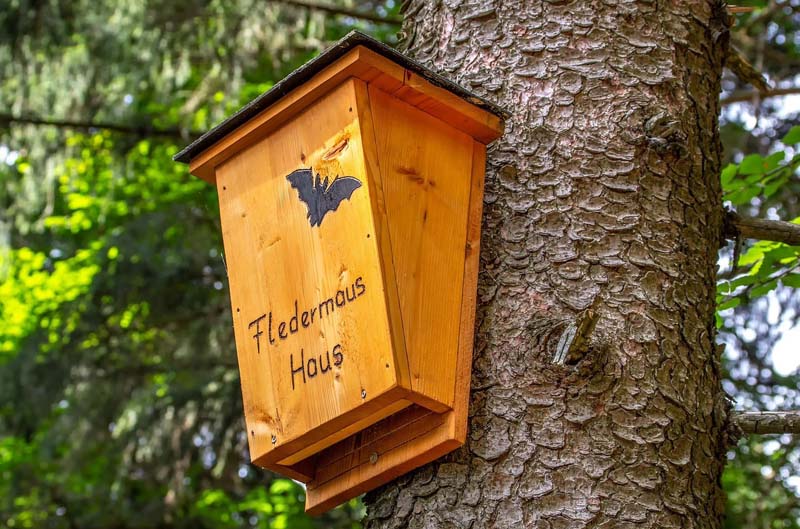
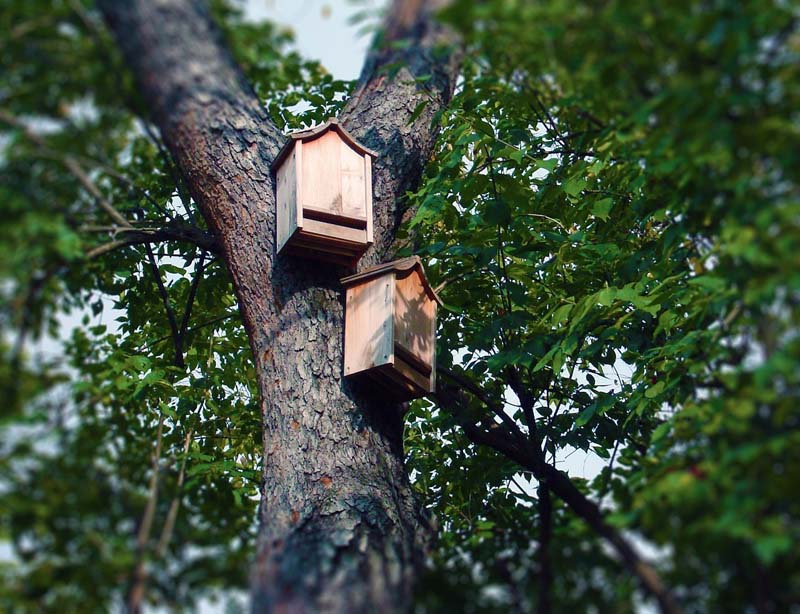
Some bat species roost in trees, especially dead trees. They will roost beneath loose bark, in tree cavities, or in crevices from damage. It is best to leave dead trees in place for this reason.
As for keeping pets inside, they should especially be kept in at night. Pets may disturb bats and cause them to leave or avoid your yard due to predators being around. Bats aren’t generally dangerous to pets, as they will not fly onto them, chase them, or intentionally come in contact with them, but you should still be aware of the potential of a rabies exposure if your pet does happen to come in physical contact with a bat.
For more information on bats, please feel free to visit Merlin Tuttle’s Bat Conservation website: https://www.merlintuttle.org/
Our friendly flying pest control!
Attracting Insects and Arachnids
Butterflies, praying mantids, spiders, and bees are some of the fun insects and arachnids you can expect to see in your yard with the right attractants. They are vital in keeping a healthy garden. Pollinating insects, such as bees, allow for your plants to reproduce and continue to flourish. With a healthy abundance of insects, birds and other predators to insects will likely check out your yard as well.
A diversity of plants will increase the amount of insects in your yard because different insects are attracted to different types of plants. Pollinators love flowers that have a strong smell to them, so try planting flowers with a strong fragrance when they bloom. Most butterflies, and some insects, find food by smell instead of by sight. Native pollinators are attracted to native plants, so be sure to choose native species to the area.
Ladybugs are great to see in your yard because they will keep the population of aphids under control, which are sap-sucking insects that damage your plants. They love the flowers of chives and dill, and also enjoy plants like marigold and yarrow.
Table of Suggested Flowers For Attracting Pollinators
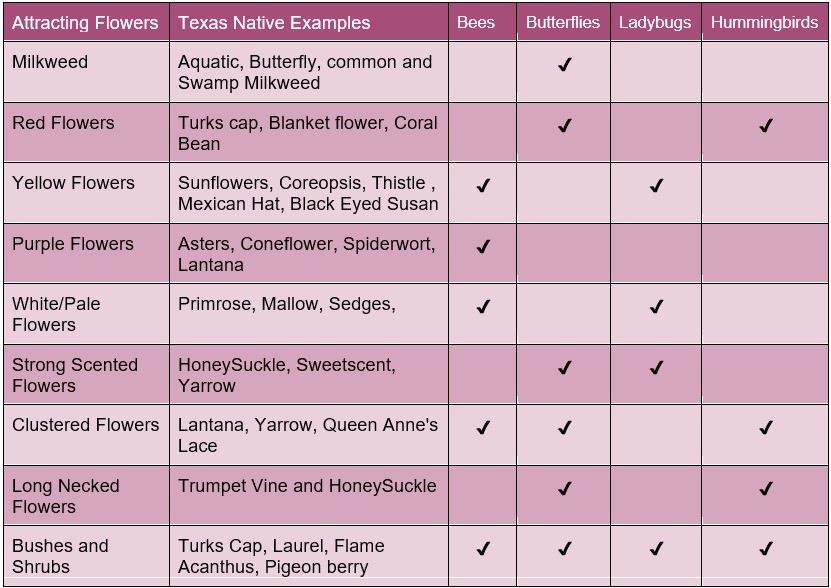
Praying mantids can be beneficial to your garden, and so much fun to watch. They feast on different insects and pests, so they are a great addition to your yard and will help control the insect population. Although they may look intimidating, they’re harmless to humans. You should plant native species of plants and grasses that their favorite prey enjoys feeding on. They will come to where the food source is. Most male adults can fly, and some female adults can fly as well, depending on the species. Evergreen shrubs are a great addition, because female praying mantids will use them not only to hide, but to lay their eggs called ootheca’s on as well. Mantids need water too, so a small dish or bowl filled with rocks or pebbles with water barely covering them will work well. You can place the dish close to where they typically hang out or hide. Carolina mantids are one of the most common native species of mantid here in Texas. If you’d like to see mantids in your yard sooner rather than later, you can actually purchase mantis ootheca’s online and let them hatch in your yard. Be aware that praying mantids will eat other large insects once they get older, such as butterflies and bees, so try to attract them to an area away from butterfly gardens or bee hotels. If you do see one in your butterfly garden, you can relocate it to a different part of the yard.
Bees need more places to call home and there are some attractants that may help bring them to your yard and thrive. Single flowers planted in clumps are the best option for bees because they are more likely to visit a clump of flowers than a single flower. A variety of colors, flower shapes, and blooming seasons can help to attract different species of bees. Because of how bees' eyes work, they are attracted to flowers that are white, yellow, blue, purple, and violet. Different species have different tongue shapes, so a variety of flower shapes is the best option. You should aim to have flowers that bloom in each different season, not all at the same time, so bees are coming to visit year-round. Some bee-friendly flowers are native sunflowers, bee balms, and asters. You should also have a safe space for bees to sit and drink where they can’t drown in the water. A bee drinking ball is a great option. They are circular glass balls with lots of ridges and bumps that you can place anywhere in your garden. Water will collect between the ridges and the bees have a safe space to land and drink the droplets of water. Other water source options include adding pebbles or floating cork to your birdbath, filling a shallow container with water and adding pebbles to the bottom of it, a self-filling pet water bowl with pebbles in the bottom of it, or filling a hummingbird feeder with just water (no sugar water). Bee hotels can be a fun addition to your yard that will attract both solitary bees and wasp species when natural habitat is limited. Each species has different requirements for the size of their individual nest, so it is a good idea to use a bee hotel that has different sizes and types of nests. Solitary species live on their own and don’t form colonies like many species do, such as honey bees. Each nest in the bee hotel will be “owned” by a single female, who then lays her eggs and gathers food needed for each offspring. She may line it with leaf pieces, mud, or glandular secretions, and she usually constructs a separate chamber for each egg. Some species will only nest in the bee hotel for only a few weeks, and will appear inactive once the female has left. If there is an intact plug or cap on the nest, it means someone is still at home.
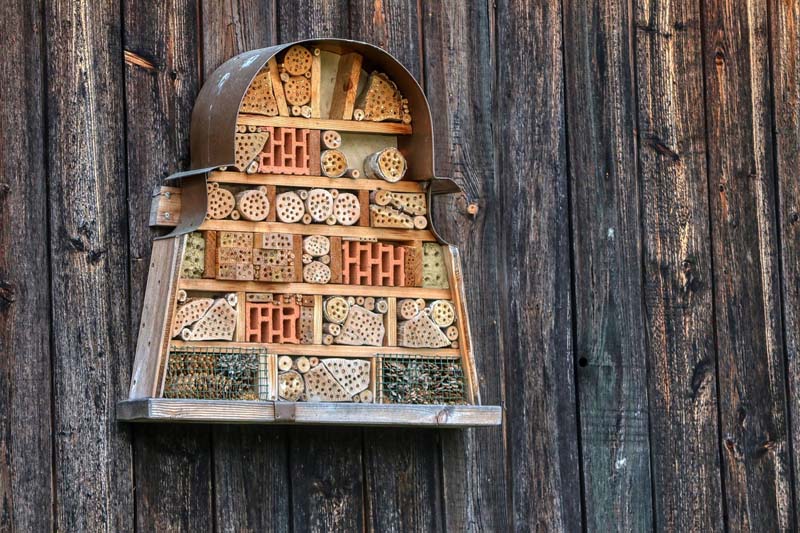
Spiders are great to have in the yard, and won’t harm your plants or environment. They eat the pests that feed on our plants and vegetables in your yard. They eat more insects than many other creatures you may find in your yard. There are a few ways you can provide an environment and shelter to encourage spiders to make a home in your yard. Shelter and places to build their webs are two of the most important aspects of persuading spiders to make a home in your yard. Some general recommendations for different spider species in your yard include:
- Place mulch, dead leaves, or grass clippings in a layer on the ground between plants for ground hunting spiders to take cover
- Let weeds grow to be slightly shorter than the vegetable plants they’re surrounding, but only let them grow in those patches near the other plants, in order to still keep control of the weeds in the yard. The weeds will provide shade and protection for spiders in the yard.
- Pots can also be placed on their side in the yard for spiders to create a habitat inside and to catch insects that get caught in its web inside
- Thick trees, bushes, and flowers will all create hiding spaces for spiders
- Weaving spiders prefer to make their webs on tall objects, so planting tall plants or sunflowers can be beneficial to them
- In the winter, you should consider leaving plants as is, and not cutting them down, so that spiders still have a place to take cover
- Permanent garden structures such as statues and light posts will give spiders a good place to form their webs
Another thing to consider is no-till gardening techniques. Tilling will likely disturb ground hunting spiders hunting grounds or cause harm to them. Spiders prefer shallow pools of water to drink from, besides natural droplets on plants, so a shallow bowl with rocks or pebbles filling the bottom and a shallow layer of water to cover the pebbles is the easiest way to create a water source for them. Overall, spiders are not out to get you, they are fun to watch, and super beneficial to have around!
Both host plants and nectar plants are imperative for butterflies to survive. Host plants are the plants that butterflies lay their eggs on. Caterpillars will eat these plants in this stage of their life. Nectar plants are flowering plants that adult butterflies drink the nectar from. One plant can be both a host plant and a nectar plant. The adult butterflies will drink the nectar from the flowering plant, while the caterpillars will eat the leaves. Some of the best native host trees and shrubs to grow in Texas are oak, plum or cherry, milkweed, willow, hickory or pecan, goldenrod, sunflower, prickly pear, bluestem, and primrose. Each host plant can attract many different types of butterflies and even moths. Adult butterflies are attracted to red, yellow, orange, pink and purple blossoms that are flat-topped or clustered and have short flower tubes. Butterfly puddlers are also a great addition to the yard. Butterflies usually drink water from puddles on the ground and take in the nutrients they need from the soil such as amino acids, minerals, and salt. You can easily create butterfly puddlers by using a large shallow plastic or clay saucer. The following is a recipe for nutrient filled water to put in your butterfly puddler:
Nutrient rich Water Recipe:
- Add sand to puddler. If you have compost or composted manure, mix half-and-half compost with sand
- Fill puddler with water to be just enough for the sand to be moist or form a shallow puddle in a low spot
- Add a pinch of salt of the puddler
- Add a few pebbles or rocks to the puddler for the butterflies to perch on
- A few slices of over-ripe fruit can also be added for some butterflies to consume as well
Butterfly houses/hibernation boxes can provide a space for butterflies to visit and hibernate inside. They are tall, slim houses with tall thin openings for the butterflies to walk through into the box. They should be placed nearby host and nectar plants, but preferably in a more wooded area, as opposed to being directly in the sun in an open-area garden. You can buy these houses or build them yourself, much like bird and bat houses. Flat stones may also be placed in the yard nearby the nectar plants for butterflies to take a quick rest on. Lastly, you can consider adding a hanging butterfly oasis to your yard. It holds nectar for butterflies to drink inside and can only be accessed by butterflies via small perforations.
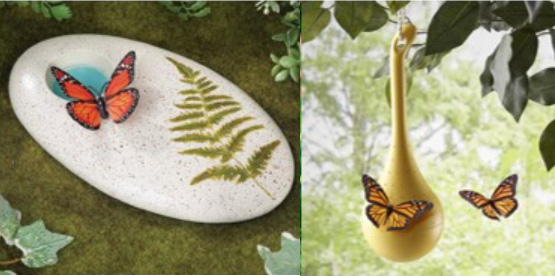
Help keep us hydrated with safe water sources!
Have Any Further Questions?
Please call us at 713-468-8972

